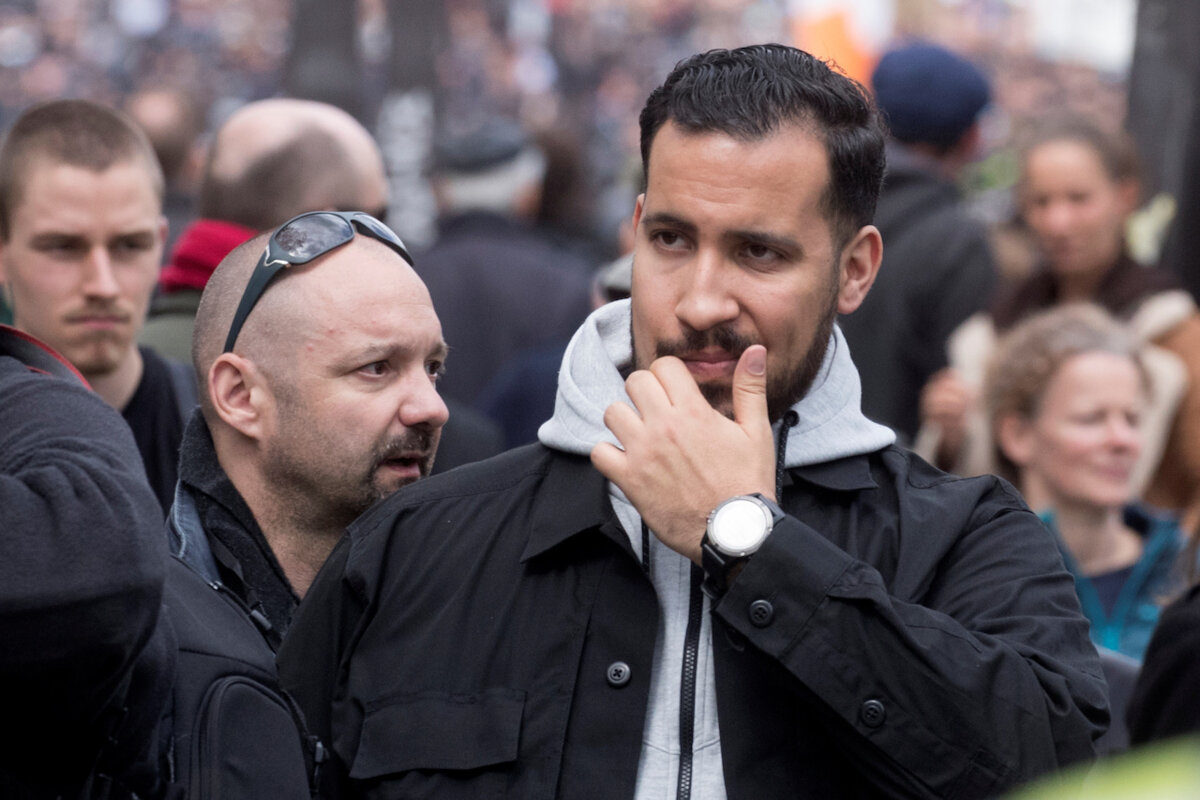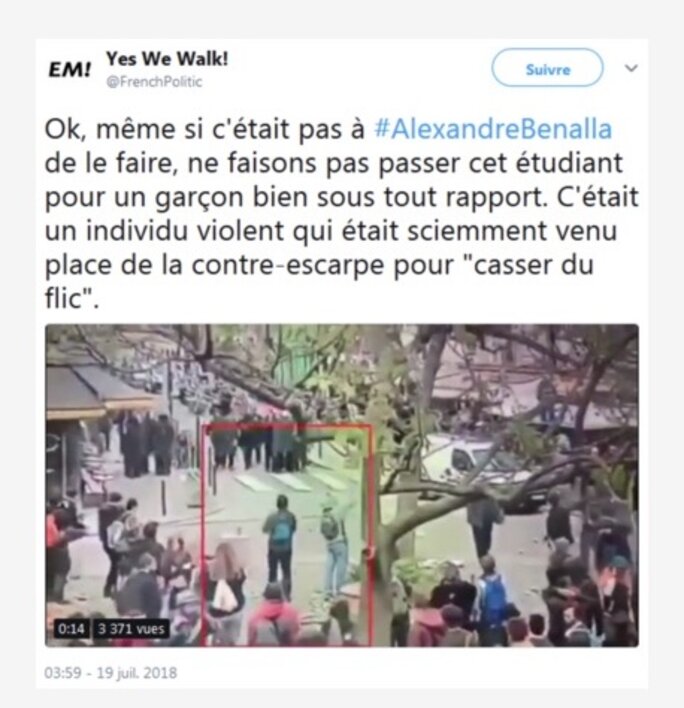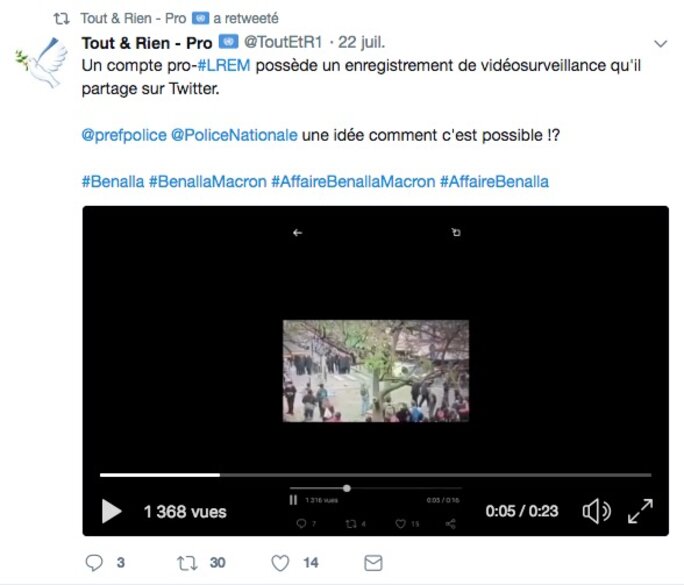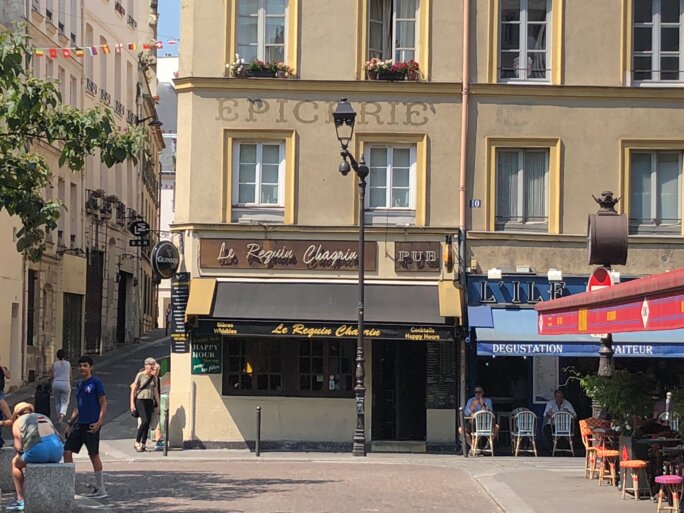Numerous videos circulating in the media since last week show President Emmanuel Macron’s private security aide Alexandre Benalla manhandling a woman and seriously assaulting her male companion in a square of the Latin Quarter in Paris on May 1st.
The first of these to be publicly revealed was published online by French daily Le Monde on July 18th, immediately prompting the gravest political crisis for Macron since he came into office last year. Benalla, 26, a former bodyguard of Macron’s who was appointed to the Élysée Palace, the French presidential office, as the new president’s close aide for personal security arrangements, was filmed by people present at the square beating and jumping on the young man while wearing police insignia.
Officially, Benalla was accompanying riot police operations as an “observer”, but the video revealed by Le Monde and also others subsequently revealed by Mediapart show he illegally played an active part in the policing, and with the consent of the officers around him.
But the scandal has since deepened, with unanswered questions over Benalla’s surprisingly rapid rise to the position of presidential aide, his influence within the police, and evidence pointing to a cover up of the events, centring on both the Élysée and senior police officials.
A judicial investigation is now underway into the events, along with separate parliamentary inquiries led by the Senate and also the lower house, the National Assembly. The latter descended into chaos this week when opposition members of the panel withdrew their participation, alleging that the commission chairwoman and others from Macron’s ruling LREM party were attempting to prevent proper examination of the events and responsibilities.
Benalla and an associate – Vincent Crase, an employee of Macron's LREM party who was filmed taking part in the violence with Benalla, while also illegally carrying a gun – have been formally placed under investigation for assault and using police insignia. Also placed under investigation are three police officers who copied and gave to Benalla CCTV footage of the violence on May Day at the Latin Quarter square, the place de la Contrescarpe.

Enlargement : Illustration 1

The footage, which is police property, was given by the officers to Benalla in a CD on the evening of July 18th when Le Monde published its first revelations. Benalla said it was offered to him to help with his defence of his behaviour, apparently showing the young man he attacked involved earlier in clashes between riot police and May Day marchers. According to Benalla'saccount, he handed the CD immediately to the Élysée.
Screenshots obtained by Mediapart, which was alerted to their existence by one of its subscribers, are evidence that these police images were posted on Twitter accounts belonging to supporters of the French president’s LREM (La République en marche) party overnight on July 18th, just hours after the first revelations by Le Monde.
In an interview with the daily published this Thursday, Benalla said he received a CD containing the CCTV images during the evening of July 18th and passed the CD on that same evening to a person he described as a “communications advisor” at the Élysée Palace.
On July 19th, after the Élysée was informed by police authorities that senior officers were implicated in passing a copy of the CCTV footage to Benalla, the presidential office handed over the CD to the Paris prosecution services.
It was at 3.59am on July 19th, as the scandal prompted by Le Monde’s revelations hours earlier was gathering speed, when extracts from the police CCTV footage were posted on a Twitter account bearing the logo “EM!” – a clear reference to Emmanuel Macron’s En Marche ! movement which was created for his election campaign (after his election, the movement became a party and was renamed La République en marche, or LREM). The extracts were accompanied by a message that read: “OK, even if it wasn’t for Alexandre Benalla to do, let’s not pass off this student as a boy beyond all reproach. He was a violent individual who knowingly went to the place de la Contrescarpe to ‘smash up cops’.”

The three police officers involved in giving Benalla the CD were last Sunday formally placed under investigation.
“I didn’t ask for it,” said Benalla in his interview with Le Monde published this Thursday. He said that “at about 10pm” on the evening of July 18th, when Le Monde’s revelations were published online, he received a phone call from “someone at the police prefecture”. He said the caller asked: “‘Alexandre, we’ve the video of the guy and his girl throwing projectiles on the CRS [riot police], do you want it for your defence?’.”
“Of course it was of interest to me,” Benalla told Le Monde. “If it could be proven that the people we faced aren’t simple passers-by but rioters. I don’t know where these images came from. I’m eating in a restaurant near to the [Élysée] Palace and someone comes to give me the CD. There is nothing written on it, neither ‘police prefecture’ nor ‘video surveillance’. This CD, I didn’t look at it and I give it [sic] to a communications advisor at the Élysée. These images weren’t released […] I think they tried to release them and give them to people, to show the reality of the events.”
Contacted by Mediapart, the Élysée Palace declined to comment on Benalla’s version of events, citing the ongoing judicial investigation into the affair. But the Élysée has confirmed a report by BFMTV that one of Emmanuel Macron’s special advisors, Ismaël Emelien, took possession of the CD.
The three police officers placed under investigation were well aware of what happened on the Contrescarpe square on May 1st. One of them, commissaire (a grade equivalent to superintendent in Britain, or captain in the US) Maxence Creusat can be seen in the different videos published in the media (wearing a helmet with twin blue stripes) leading the young man Benalla assaulted, along with his female companion, to a group of CRS riot police for arrest – on Benalla’s insistence.
Another is Laurent Simonin, a senior officer with the Public Order and Circulation Directorate (the DOPC) who, prior to the May Day policing operation, had given Benalla a bag of equipment to use during the day. The third is Jean-Yves Hunault, a commissaire appointed as a liaison officer between the Élysée and the police prefecture and who was also fully aware of the events on the place de la Contrescarpe.
According to a source close to the case, the three men concerted between themselves as soon as the scandal broke. It was, said the source, Creusat who had initially selected the images of the events in the square, and the three contacted Benalla on July 18th to offer him a copy, which was delivered to him by Hunault – after which, according to his account to Le Monde, Benalla immediately passed on the CD to the Élysée.
In the early hours of July19th the images began circulating on social media before being deleted a short while later. These included a Twitter post from the @FrenchPolitic account with the logo of Macron’s En Marche ! movement, which was removed in the afternoon of July 19th. The images were relayed by other pro-Macron accounts, while others, reacting to the buzz, questioned how the police CCTV footage ended up on Twitter accounts of pro-Macron party supporters (see below).

It is unclear whether the images posted on Twitter alerted the senior hierarchy of the police to the fact that the CCTV footage had been made public, but in his testimony on Wednesday to the Senate commission of inquiry into the Benalla affair, Paris police chief Michel Delpuech said it was at around 2pm on July 19th that the director of the force’s Public Order and Circulation Directorate (the DOPC), Alain Gibelin, asked to meet with him “without delay”.
“And then he reveals to me with astonishment, and a little shattered, that commissaire Creusat had just revealed what he had done along with two colleagues, that’s to say retrieved the images that were taken on the place de la Contrescarpe to give them to Mr Benalla,” Delpuech told the senators.

Enlargement : Illustration 5

Delpuech said he asked the three officers to give him a “written report” about the matter and then contacted by phone the Paris public prosecution services, and following that up with a call to the interior minister. Testifying separately before the National Assembly commission of inquiry, Delpuech and Gibelin both said that it was that move which prompted the launching of a preliminary investigation by the prosecution services, and was made in respect of Article 40 of the French penal code. Article 40 requires anyone exercising a post of authority and who in the exercise of their duties learns of a crime or offence that has been committed is by law required to inform the public prosecution services.
Delpuech has claimed that he has no knowledge of the precise contents of the footage the three officers passed on to Benalla. But according to a source close to the current investigation, copies of the CCTV footage were made as of May 2nd, the day following the disturbances on the Contrescarpe square, and commissaire Creusat wrote a report to his superiors about the images.
Testifying before the Senate commission of inquiry on Thursday, Macron’s chief of staff, Élysée Palace secretary general Alexis Kohler, said that he was alerted by Delpuech on July 19th about the provenance of the CD handed to Benalla. “On the subject of the video surveillance tape, as soon as there [was] doubt about the origins of this video, in an alert from the prefecture, and then after a meeting I held on the same day, we decided to proceed with filing a report with respect to Article 40, to return and address the video elements in our possession to the public prosecutor and to proceed with the dismissal of Alexandre Benalla on that basis, from the moment we had the least doubt,” Kohler, in somewhat awkward phrasing, told the senators.
Meanwhile, Delpuech has said that because CCTV footage like that which was recorded by the cameras on the Contrescarpe square is by law only kept for a period of 30 days “it must be made known and understood” why that had not been the case, and he said he had already begun an internal inquiry into the matter.
The three police officers implicated in the case were suspended from duty as of July 19th, awaiting the outcome of the judicial probe in which they are placed under investigation for violating professional secrecy and misappropriation of images from a video protection system.
Under French law, charges are only brought at the end of a judicial investigation which is led by one or more magistrates, and who may also decide not to press charges. In the meantime, a suspect against whom there is “serious and concordant” evidence that they committed a crime can be placed under investigation, effectively meaning that they face being charged and sent for trial.
As for Alexandre Benalla, he is now placed under investigation for assault, illegally involving himself in a police operation, publicly and illegally wearing police insignia, misappropriation of images from a video protection system and violation of professional secrecy.
-------------------------
- The French version of this article can be found here.
-------------------------
If you have information of public interest you would like to pass on to Mediapart for investigation you can contact us at this email address: enquete@mediapart.fr. If you wish to send us documents for our scrutiny via our highly secure platform please go to https://www.frenchleaks.fr/ which is presented in both English and French.
-------------------------
English version by Graham Tearse


